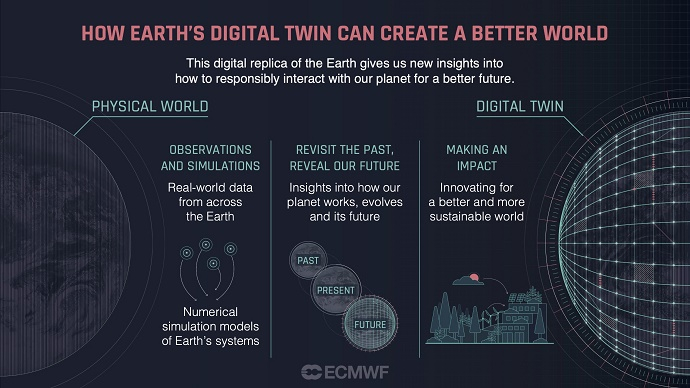

The EU’s Destination Earth (DestinE) initiative, which is developing a novel information system around highly accurate digital twins of our planet, will hold its second User eXchange meeting on 13–14 November 2023 in Bonn, Germany. DestinE is implemented by ECMWF, EUMETSAT and ESA.
In coordination with stakeholders, ECMWF is developing the Digital Twin Engine and the first two digital twins; ESA is setting up a Core Service Platform to provide access to the digital twins; and EUMETSAT is creating a Data Lake, a data repository that can be accessed by users of DestinE.
A first version of the system is scheduled to work from next summer. Registration for joining the User eXchange meeting on-site closes on Sunday, 22 October.
State of play
DestinE was formally started at the beginning of 2022. The idea is to create digital twins of the Earth system to support climate change adaptation policies and decision-making for reducing the impacts of weather-induced extremes.
Two digital twins are under development. One is on climate change adaptation and has been contracted out to a consortium led by Finland’s CSC – IT Center for Science. The other one is on weather-induced extremes. This includes an on-demand component, which has been contracted out to a consortium led by Météo-France, and a continuous component, which is being implemented by ECMWF.
The on-demand component of the extremes digital twin aims to offer resolutions down to 500–750 metres, while the continuous component will probably run at a 2–4 km.
“We are well advanced with the continuous component of the extremes digital twin,” says ECMWF’s Jörn Hoffmann. “It is currently running in test configurations at different resolutions, such as 4.4 and 2.8 km.”
ESA has also made good progress with the Core Service Platform, and EUMETSAT with the Data Lake, so that a demonstration system should be ready by June next year.

The User eXchange meeting
The purpose of the meeting is to support the shaping of a user community around DestinE. “It’s bringing together potential users to inform them about the progress and opportunities DestinE brings,” Jörn observes.
At the same time, participants can articulate the requirements they would like DestinE to fulfil. Since there is no operational system or services open to the public yet, many of the people attending are expected to be quite close to the development of the system, but they will also include potential end users.
ECMWF plays a big role in the topics to be covered. “We’ll be covering all developments that have been happening over the last year, and how far we’ve got in all elements of the system,” says Jörn. “Then there’ll be more detailed discussions on the two digital twins, trying to engage prospective users to see what their needs are and how they may interact with the systems.”
There will also be specific sessions on the components to be provided by ESA and EUMETSAT.
ESA’s Core Service Platform is the main user access point to DestinE – a system where users can set up an account. They can then interact with DestinE, e.g. by searching for data and DestinE services, also gaining access to some computational resources.
EUMETSAT’s Data Lake is the repository of DestinE data. It represents a big storage facility, which also manages external data resources, based on the concept of federation: existing data archives and data access points are included in the Data Lake. The Data Lake thus provides interfaces to the DestinE data and also near-data processing services.
Finally, there will be sessions looking at the larger science and technology context relevant to DestinE, and the interoperability with other digital twin initiatives that exist in Europe and worldwide.
“We already have over 200 participants registered, online or in person,” says Jörn. “It promises to be an interesting and productive exchange.”

